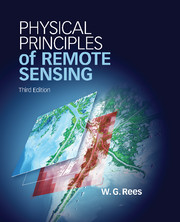Book contents
- Frontmatter
- Contents
- Preface
- Acknowledgements
- 1 Introduction
- 2 Electromagnetic waves in free space
- 3 Interaction of electromagnetic radiation with matter
- 4 Interaction of electromagnetic radiation with the Earth's atmosphere
- 5 Photographic systems
- 6 Electro-optical systems
- 7 Passive microwave systems
- 8 Ranging systems
- 9 Scattering systems
- 10 Platforms for remote sensing
- 11 Data processing
- Appendix Data tables
- References
- Index
- Plate Section
1 - Introduction
Published online by Cambridge University Press: 05 December 2012
- Frontmatter
- Contents
- Preface
- Acknowledgements
- 1 Introduction
- 2 Electromagnetic waves in free space
- 3 Interaction of electromagnetic radiation with matter
- 4 Interaction of electromagnetic radiation with the Earth's atmosphere
- 5 Photographic systems
- 6 Electro-optical systems
- 7 Passive microwave systems
- 8 Ranging systems
- 9 Scattering systems
- 10 Platforms for remote sensing
- 11 Data processing
- Appendix Data tables
- References
- Index
- Plate Section
Summary
‘Remote sensing’ is, broadly but logically speaking, the collection of information about an object without making physical contact with it. (The term was coined by Evelyn Pruitt of the US Office of Naval Research in the 1950s.) This is a simple definition, but too vague to be really useful (Campbell 2008), so for the purpose of this book we restrict it by confining our attention to the Earth’s surface and atmosphere, viewed from above using electromagnetic radiation. This narrower definition excludes such techniques as seismic, geomagnetic and sonar investigations, as well as (for example) medical and planetary imaging, all of which could otherwise reasonably be described as remote sensing, but it does include a broad and reasonably coherent set of techniques, nowadays often described by the alternative name of Earth observation. These techniques, which now have a huge range of applications in the ‘civilian’ sphere as well as their obvious military uses, make use of information impressed in some way on electromagnetic radiation ranging from ultraviolet to radio frequencies.
One important casualty of our restricted definition of remote sensing is the use of spaceborne methods of measuring the Earth’s gravitational field. Although observations from artificial Earth satellites have been used since the 1970s to measure the Earth’s gravity, our current (at the time of writing, in 2012) ability in this regard is a remarkable indication of the level of space technology. This is the GRACE (Gravity Recovery and Climate Experiment) mission, launched in 2002. Two satellites, each with a mass of around half a tonne, follow the same orbit 500 km above the Earth’s surface. They are approximately 220 km apart, and the distance between them is constantly monitored with an accuracy of 10 µm. This distance changes as the satellites cross regions of different gravitational field strength. The GRACE system is sensitive enough to respond to changes in groundwater in a large river basin. Data from the GRACE mission are described in Chapter 8.
- Type
- Chapter
- Information
- Physical Principles of Remote Sensing , pp. 1 - 10Publisher: Cambridge University PressPrint publication year: 2012



